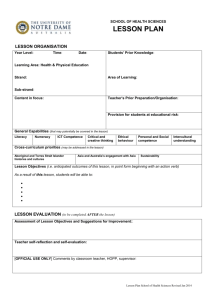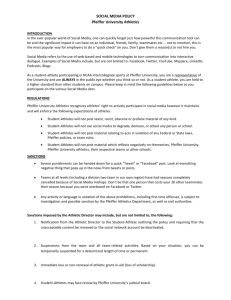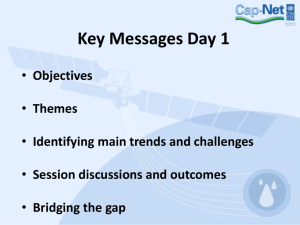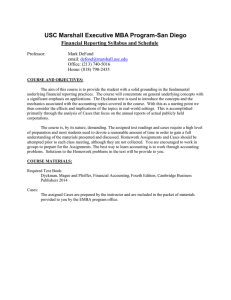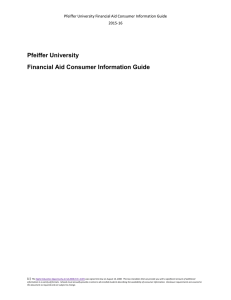Transformation of institutional to community based care
advertisement
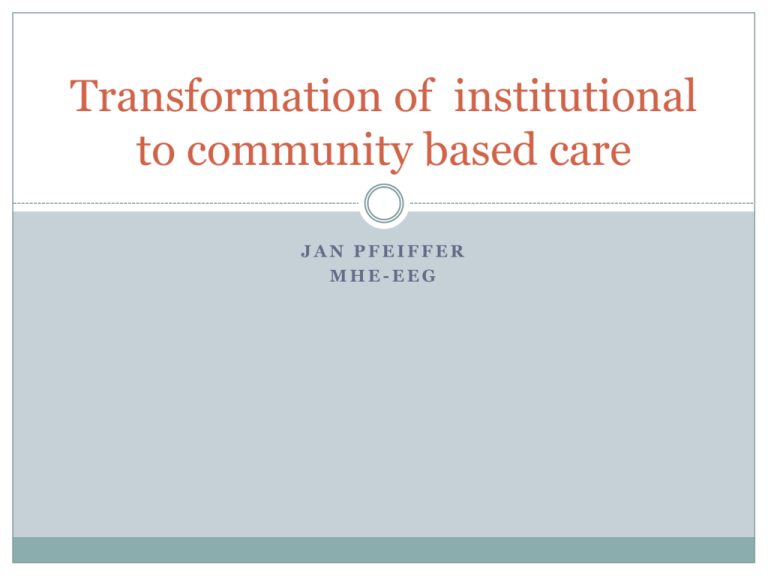
Transformation of institutional to community based care JAN PFEIFFER MHE-EEG What is deinstitutionalization? From institutional culture To on client oriented culture Isolation from the community Inclusion in the community Clients are compelled to live together Clients decide where and with whom to live Lack of control over their lives Maximum support for clients to gain control over their lives Rigidity of routine Normalization principle Block treatment Needs-based support Paternalistic relationship Partnership between staff and clients Social distance Team cooperation Rules of the institution are more important than the needs of the clients Flexibility in care provision Changing a paradigm of support From disability-medical model To person centered - recovery model What is recovery? “Recovery is a way of living a satisfying, hopeful and contributing life, even with limitations caused by disability-illness.” (W Anthony, Boston University, 1993) - and another ! “Recovery isn’t waiting for the storm to pass. ………………. It’s learning to dance in the rain.” Recovery processes: Leamy et al, 2011 Leamy, M., Bird, V.J., Le Boutillier, C., Williams, J. & Slade, M. (2011) A conceptual framework for personal recovery in mental health: systematic review and narrative synthesis. British Journal of Psychiatry, 199:445-452 http://www.researchintorecovery.com/ Focus on wellbeing . UN Convention on the Rights of Persons Disabilities Art.19: Living independently and being included in the community • • Equal right of disabled people to live in the community with choices equal to others States must take effective and appropriate measures to facilitate disabled people’s: – Full enjoyment of this right – Full inclusion & participation in the community (note: emphasises that it is not just about where the person lives) This includes ensuring that people have: • • • Equal opportunity to choose where & with whom to live Access to range of community-support services Equal access to mainstream services (that are responsive to individual needs) Balance between community and institutional resources History counts Europe and the Cold War (1947-1991) Structural Funds allocation (2007-2013) Services neglect basic human rights Public opinion- stereotype of Weaknesses segregation Most of the resources fixed in the institutional care Community services do not have stable financing DI policy not implemented Lack of objective knowledge about alternatives to institutional care among professionals Instability of civil servants system Corruption Lobby of pharmaceutics companies Examples of “reformed” system Good examples of creative – inclusive, Strengths recovery based community care services Examples of deinstitutionalization of social care homes using a SF National mental health policy (action plane) Revision of legal capacity law NGO representing opinion of different groups include NGO “controlled” by users National DI platforms Cases in Human Right Court CPT recommendations have a comments to whole system, not only improving condition SF used on refurbishing of Threat institutional care Closing down community services due to reduction of resources Exhausting of pro reform fighter, mixing up role of advocacy and service provider, fragmentation of the voice Leadership in DI missing Overinvestment in existing institutions Developing community service without closing the institution Alternatives with institutional culture Horizontal institutions - group homes in segregated area, often placed on the ground of the original institution. Most frequent fears on the beginning Fears Solutions There is no money for DI Cost analysis research Use of Structural Funds as a Community care costs more Clients are happy in the institution Clients are not capable of living independently Clients are a danger for themselves or others Community will not accept “clients” among themselves bridging fund Prevention services to avoid unnecessary new admissions Share experience with places where the reform process is ongoing Continuous communication: timely and objective information sharing at national and local level, involving concrete personal stories. Involvement to planning. Comprehensive, understandable strategy and implementation plan Moving out from the institution Analysis of the needs of clients and others involved (family) Analysis of the resources in the community Design of alternative services Plan for closing down the institution and development of new services Preparatory work with clients, staff and the community Move from the institution to the community Monitoring and evaluation of the process Principles of transition process Involvement of users Prevention of institutionalization Restriction of investment to institutions Development of community services Closure of institutions Effective use of all resources Development of human resources Control of quality Holistic coordination Continual awareness Basic principles Catchment area responsibility Gate keeping Referral system Focusing and prioritizing Coordination structure across different services and agencies Shared philosophy of care Allocation of money supporting change – follows the client Quality monitoring and evaluation When not to count investments Costs running costs are the same as in institutions For people with complex needs, care is more expensive For people with moderate needs, the cost is the same or lower Additional incomes from employment of the clients More coherent use of available EU funds │ 22 Common Strategic Framework Partnership Contract Operational Programmes Comprehensive investment strategy: aligned with Europe 2020 objectives Coherence with National Reform Programmes Coordination: cohesion policy, rural development, maritime & fisheries funds Objectives and indicators to measure progress towards Europe 2020 targets Effectiveness: introduction of a performance framework Efficiency: reinforcement of administrative capacity, cutting red tape EU Structural Funds as bridging fund for DI (experience from pilot projects) ERDF ESF Housing facilities Analysis - policy Asylum and crisis centers Day program centers Mobile teams basis Residential facilities Inclusive schools New use of buildings of the institutions development Methodology development Awareness campaign Training of new staff for new services Requalification of staff in existing institutions Specialized foster care development Exchange a good practice in DI Opportunities SF used for moving DI forward, as bridging funds To create national pro DI task force ( platform) CRPD framework to be used to put DI as political, human right agenda EEG can play a role in linking local DI group together, supporting DI lobbying, linking with good practices and getting in contact with EU commission DI is about balancing among different obstacles but keep smiling Thanks for your attention For further information JAN PFEIFFER Mental Health Europe – Santé Mentale Europe Boulevard Clovis 7, B-1000, Brussels Tel. +32 2 280 04 68 Fax +32 2 280 16 04 www.mhe-sme.org Or md.jan.pfeiffer@gmail.com


